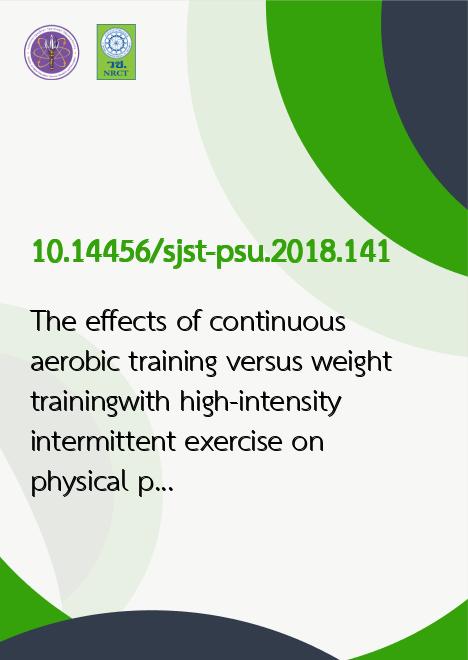
|
The effects of continuous aerobic training versus weight trainingwith high-intensity intermittent exercise on physical performance,hormonal responses, and psychological fitness in Thai military |
|---|---|
| รหัสดีโอไอ | |
| Creator | 1. Sumate Kunching 2. Werner Kurotschka 3. Thamthiwat Nararatwanchai 4. Eakrat Onnom 5. Tawee Saiwicha |
| Title | The effects of continuous aerobic training versus weight trainingwith high-intensity intermittent exercise on physical performance,hormonal responses, and psychological fitness in Thai military |
| Publisher | Research and Development Office, Prince of Songkla University |
| Publication Year | 2561 |
| Journal Title | Songklanakarin Journal of Science and Technology |
| Journal Vol. | 40 |
| Journal No. | 5 |
| Page no. | 1144-1151 |
| Keyword | weight training with high-intensity intermittent exercise, physical performance, hormonal responses, psychologicalfitness |
| URL Website | http://rdo.psu.ac.th/sjstweb/index.php |
| ISSN | 0125-3395 |
| Abstract | This study aimed to compare the effects of continuous aerobic training (CAT) versus weight training with highintensityintermittent exercise (WT/HIIE) on physical performance, hormonal responses, and psychological fitness in air forcemen. Forty-one participants were randomly allocated to the control group (CON), CAT, and WT/HIIE. The CAT and WT/HIIEwere designed to yield the same energy expenditure/session. Both groups performed 3 times/week for 12 weeks. Results showedthat the CON showed no significant change in all parameters. Both CAT and WT/HIIE increased (p<0.05) muscular strength(leg), muscular power, speed, testosterone, testosterone/cortisol ratio, mental state and mental health. Only WT/HIIE decreased(p<0.05) cortisol, stress level and increased (p<0.05) muscular strength (chest), muscular endurance, aerobic capacity, insulinlikegrowth factor 1, and mental quality. We concluded that both CAT and WT/HIIE were effective in improving physicalperformance, hormonal responses, and psychological fitness in air force men, but the WT/HIIE appeared to confer greater overallimprovements than the continuous aerobic training program. |
